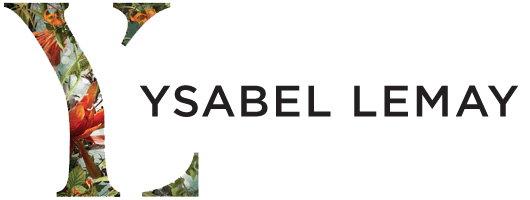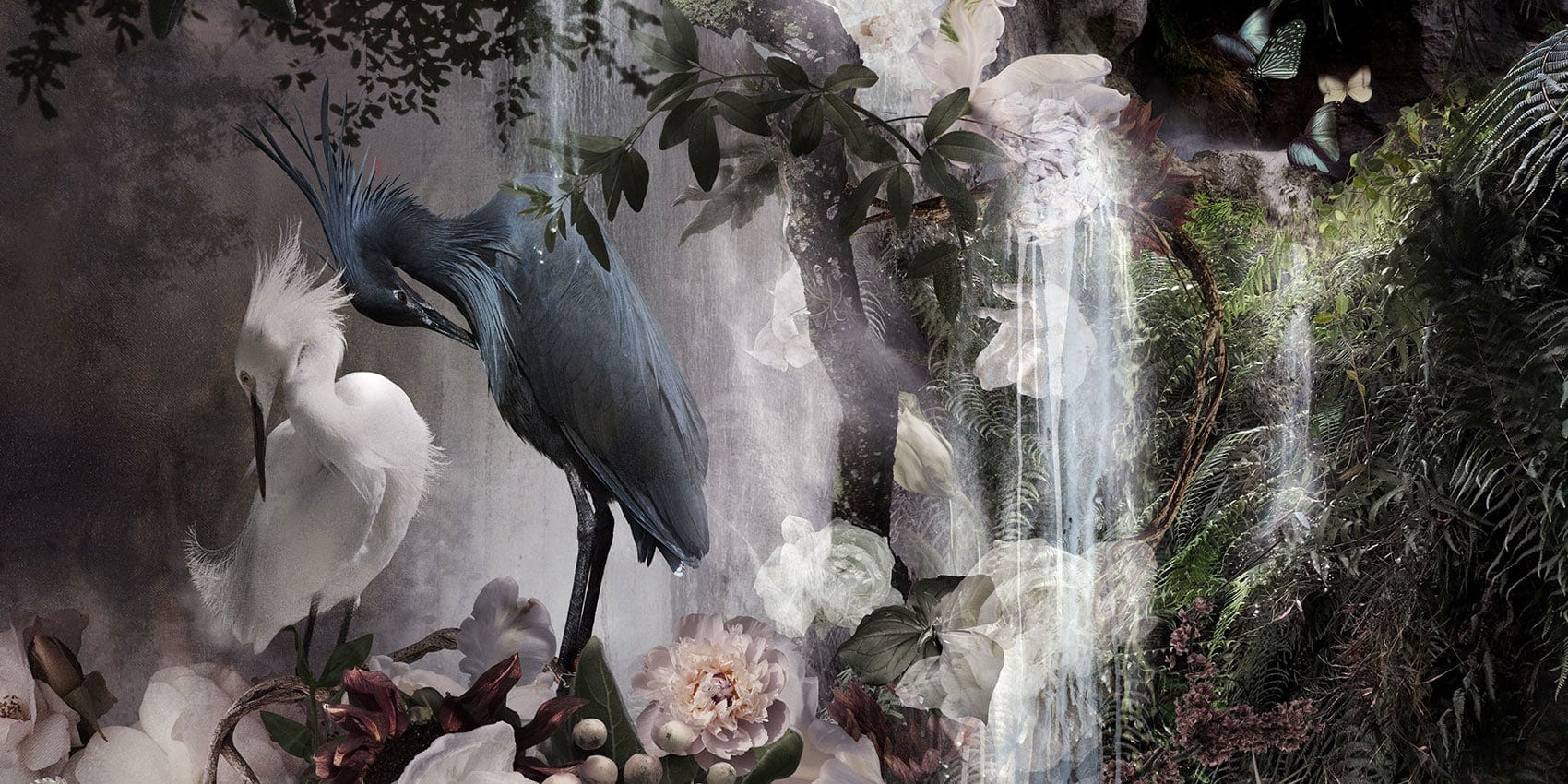Recording Artists: Two photographers document changing environments
Michael Abatemarco
Posted: Friday, September 19, 2014 5:00 am
Pasatiempo link
[column-third-1]
Though Irving Greines and Ysabel LeMay, photographers with work currently on view at Verve Gallery of Photography, have quite different approaches to creating their images, both consider their projects to be expressions of the organic. The pieces in LeMay’s Gracia show are constructed compositions, photomontages of many elements. Greines’ Portrait series, his latest installment in an ongoing body of work exhibited under the title Urban Wilderness — Chaos Transformed, is a selection of straightforward, unaltered photography. “Where I like to wander is in the blighted areas of cities, and the walls are often filled with layer upon layer of writing — political messages, personal messages,” Greines told Pasatiempo. “Those areas are usually avoided. People don’t pay attention to what’s on the walls, really. It was challenging to me to be able to isolate parts of that urban chaos and make a statement that I hope is somewhat beautiful.”
Greines began his Urban Wilderness — Chaos Transformed series in the early ’90s, shooting first in San Francisco and later in New York, Los Angeles, Paris, and Rome. The photographer focused on major cities because of their abundance of structures bearing affiches plastered on with wheat paste. Wheat paste degrades over time to reveal layers upon layers of paper, paint, and plaster from such ads and posters. “In New York, in particular, and certain areas in Los Angeles where most of this show was shot, you can see the evolution of an image. I’ve recorded changes over time. Sometimes, over the course of three or four days, you can see a transformation from one thing into a completely different thing, and it can also happen overnight. I will sometimes show that in photographs.” For Greines, these sites where numerous people interact with printed materials on city walls — either by defacing them or adding embellishments with spray paint and markers — represent a public venue for self-expression, the record of humans interacting with their immediate environments. In addition, the elements take their toll. “These walls are like living organisms, and they change almost in the same way as nature changes,” he said. “I’m hiking through the urban wilderness and trying to capture the changes.”
Urban renewal also brings changes to the environments Greines shoots in, but the results are often an erasing of the interactions and mark making he documents. What’s more, gentrification doesn’t always make an urban landscape more attractive. During the decades Greines has spent wandering around inner-city streets and alleys, he has seen his share of such “improvement.” “The stuff I photograph is basically condemned by most people. You know: graffiti artists are basically bad guys. The question is whether graffiti adds something interesting and beautiful to the sameness that’s being built in everywhere around us. There are things of beauty you can find if you simply stop and take the time to look. I’ve met a number of the taggers. I’m interested in what they’re doing, and they’re interested in what I’m doing. I once had a show in Atlanta with all of these former New York taggers, all of whom had been arrested at some point and are now doing their work on canvas. My work captured the kind of stuff they did when they were still street taggers.”
Greines’ portraits are all photographs of people. His Madonna, a triptych, is a trio of shots of the same poster taken in three Los Angeles locales, each one altered by the elements or human intervention. One image of the fameous singer and dancer’s face is embellished with a spray-painted eye mask. Another is peeling away to reveal text from previously affixed material that’s been covered over. “I tried to capture the exact same positioning of the eyes and mouth to show how you’ll find that image again and again in different ways. I must have 50 variations of that image, but chose only three for the show.”
[/column-third-1]
[column-third-2]
Ysabel LeMay combines elements in her symphonic visions of nature that come from her own photographs — but, unlike Greines, she does not frame and crop photographs as she shoots them or present her works as she found them. LeMay’s technique is painstaking and time consuming. “I take a trip four times a year and focus on getting images,” she told Pasatiempo. “I go to different environments where I know I will find new things. I just create a lot of images and work over a period of three to four months.” After gathering photographs, LeMay works digitally, removing backgrounds from her shots and extracting elements such as flowers, birds, and trees for later use. Her aim is to create — using photographs — compositions that have a painterly feel. “The reason is that, before touching a camera for the first time, I was a painter for almost 10 years. All of my understanding of space and composition was learned through painting techniques. When I moved to digital components, a photo-grapher who documented my life as a painter offered me a small camera. When I came to photography, I created landscapes that had a strong reference to the history of art — the Flemish painters.”
LeMay, a former minimalist, cites two painters as influences. “One of the painters is Martin Johnson Heade. He was born in 1819. His influence was Romanticism, but he brought Surrealism into his work. He was part of the Hudson River School, but he took the classic approach of that school — the light and landscape quality — and he was playing with the size of the forms, and it was very Surrealist. It was a strong influence in terms of color palette. Another influence — and, strangely enough, her work has nothing to do with mine — is Joan Mitchell. The reason I was inspired by this person is the energy behind her brushstrokes. She’s a woman who managed to rise with the boys during the Abstract Expressionist period. My work, as soft as it can be, is bold as far as verbal language goes. You can recognize my work a mile away, just as with Joan Mitchell’s.”
LeMay’s imagery has a baroque quality: it is intricate and has ornate details. The compositions are cohesive and their components are carefully selected to exist with one another in a way that appears natural. “Extractions are the work of a month. This takes the most time. Flowers are easy to extract, but when I get to trees or foliage, it can be very complex.” Much of her work is full of light that penetrates through pale flowers or saturates sections of a piece, washing out the imagery around it. In Cosmic Nursery, white paint drips appear to be pouring from a light-filled sky. “When I created that one, I had promised myself to have a breakthrough in my imagery. I wanted to be bolder. I struggled terribly with that piece. In a very serene landscape, I put in elements that put you on your toes. I’m playing with polarity — from very soft to something that puts you out of your comfort zone. It’s an expression of what it is to try to break new ground, the chaos behind creating new work.”
Irving Greines: Portraits (part of the ongoing Urban Wilderness — Chaos Transformed series) & Ysabel LeMay: Gracia
Opening reception 5 p.m. Friday, Sept. 19, 2014;
exhibit through Oct. 25, 2014
Gallery talk 2 p.m. Saturday, Sept. 20
Verve Gallery of Photography, 219 E. Marcy St., 505-982-5009, www.vervegallery.com
[/column-third-2]
[column-third-3]
[/column-third-3]







